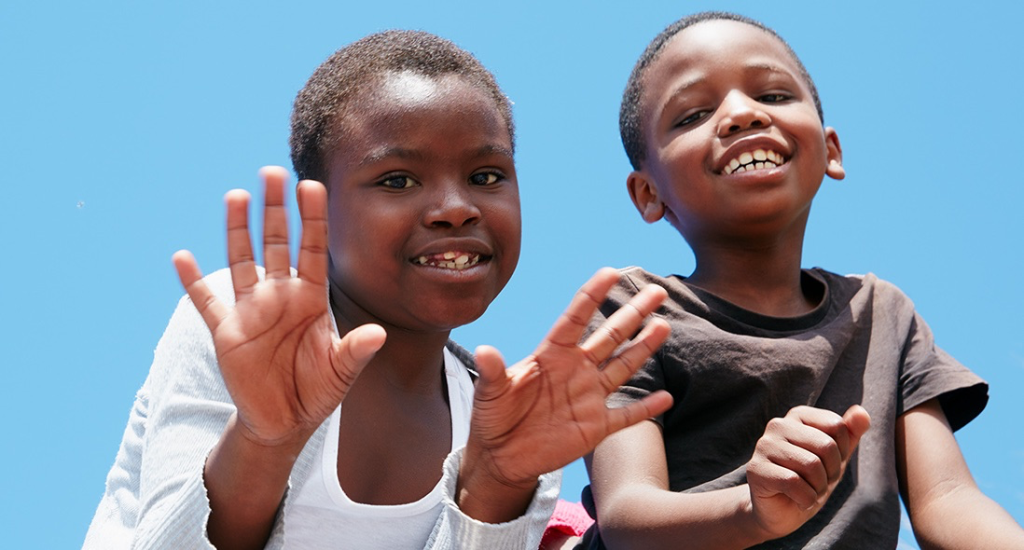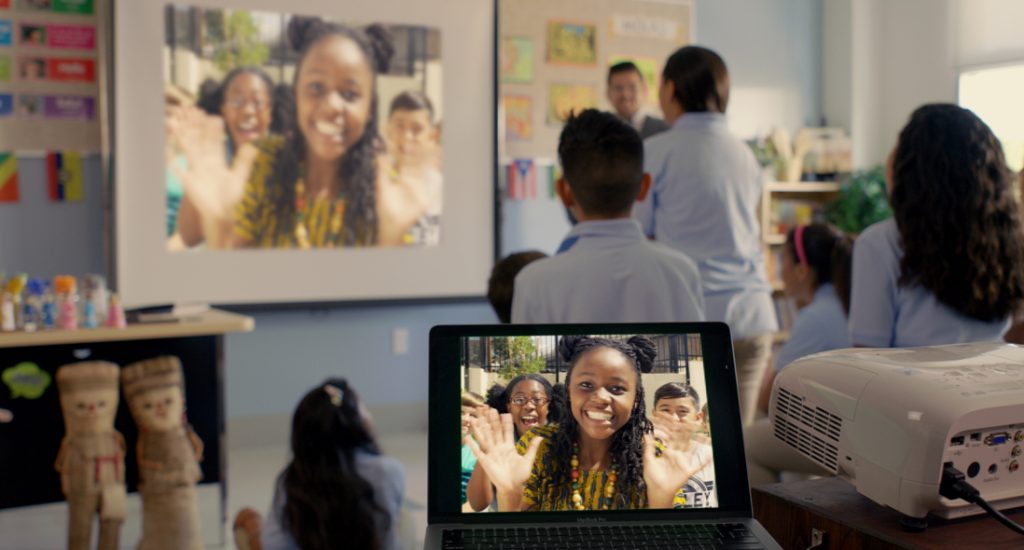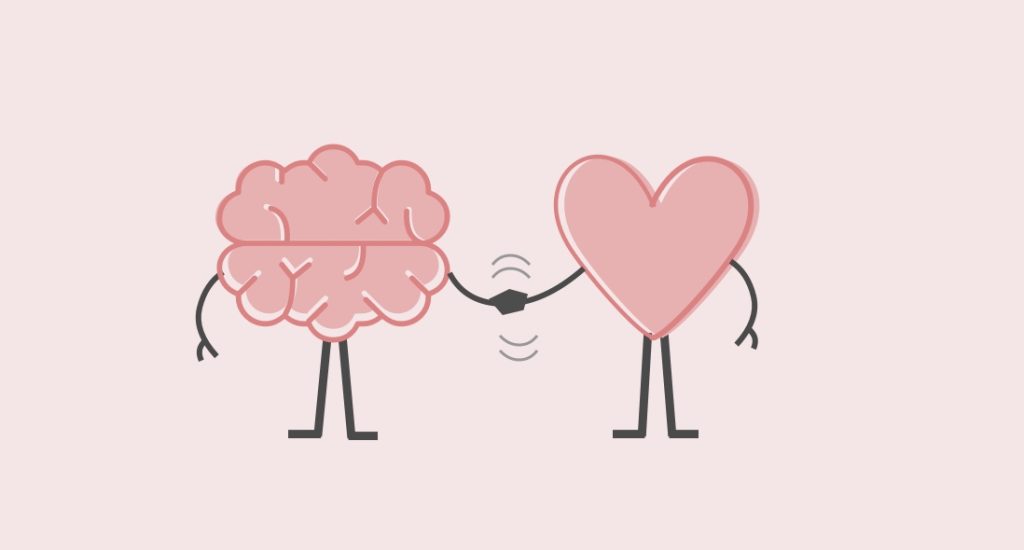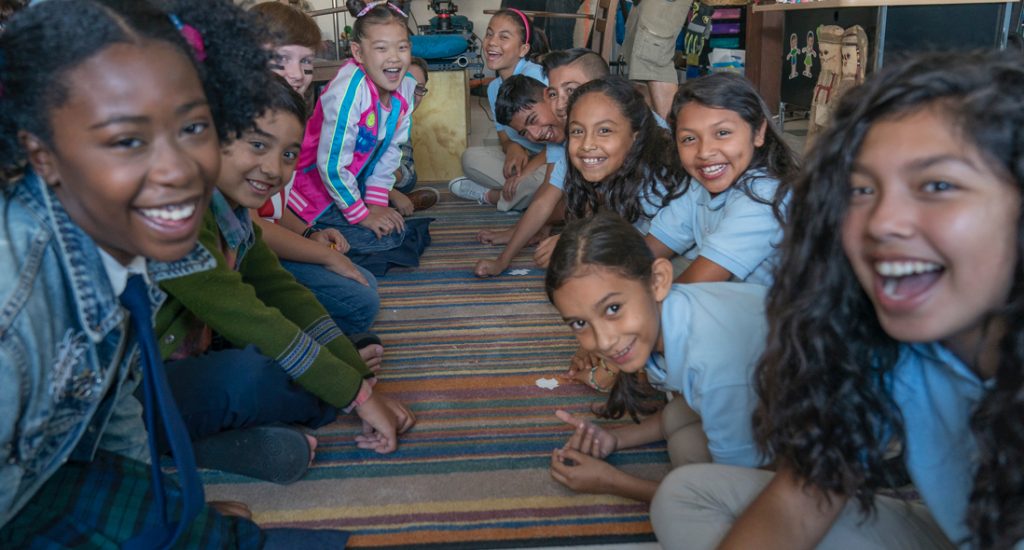The ability to understand another person’s perspective can help with students’ social skills and relationships within the classroom and beyond, which can have a profound effect on everything from classroom culture to individual student learning and mental health.
Perspective taking is one of the first steps to relating to another person’s life experiences as it enables students to recognize that others can have different thoughts, feelings, and knowledge. It also helps students understand that someone’s perspective may be related to their unique experiences, beliefs, and culture. There is often a reason behind someone’s actions that we cannot see. Perspective taking is one of four core skills we highlight in all Empatico activities to support meaningful connections between classrooms that meet and collaborate virtually through our online tool.
As an educator you can help your students practice perspective taking through a number of small yet meaningful daily practices, such as:
- Help students get into the mindset of another person or character when reading stories, watching movies, or acting out skits to understand their thoughts and feelings. You can also ask students how stories or skits might end differently if told from another character’s point of view.
- When conflicts arise between peers or between characters in a story, help students understand how and why each side perceives the situation differently and, in the case of peer conflict, guide them toward a solution that acknowledges both perspectives.
- Be sure to encourage perspective taking when students are learning about other cultures or ways of life, or meeting people from different backgrounds.
Below are a few ‘mini-lessons’ you can also try in your classroom to practice perspective taking. These mini-lessons can be adapted to teach perspective taking across all elementary grade levels.
Mini-lessons to teach perspective taking in your classroom
Lesson #1: Same situation, different perspectives (estimated time: 45-60 min)
1. Explain to students that first they will write about their own feelings in response to various situations (outlined below). Next, they will listen to or read a story about a student their age named Tom, and then write about Tom’s feelings in response to the same situations.
2. Read each situation aloud with the class. After reading each situation, pause and ask students to imagine how they would feel if that were happening to them, and write down their feeling (“I feel____”) and reason (“because…”).
3. Read “Tom’s Story”: Remind students to listen carefully to the story for details about Tom’s life that might influence how he feels about the situations described. Then, read the story aloud.
4. Read each situation aloud again. Pause after reading each situation to:
- Ask students how Tom might feel about that situation and why. Refer back to the story if needed, and discuss as a class.
- Then ask students to look on their handouts to see if they had different feelings than Tom about each situation, and if so, raise their hands.
- Call on students to explain why they think Tom feels differently than they do. Guide them toward understanding that people can have different feelings about the same situation because of different past experiences, preferences/interests, immediate circumstances, or cultural influences.
5. Conclude with a discussion on perspective taking: Explain to students that the only part of a situation we can actually see is the person’s reaction, but there is usually a lot going on under the surface that influences how this person perceives the situation, as we saw with Tom (see the iceberg image below for a visual understanding – you might want to display this for students or draw it on the board). To better understand another person’s perspective, we need to think about all these hidden influences of the iceberg and ask ourselves: “What is life like for that person? What might be influencing how they perceive this situation that we can’t see? How can I relate to their experience to understand how they feel?” For example, although a student might feel happy about blueberry cake while Tom feels disappointed, the student can still relate to Tom’s experience by recalling how she felt when she was given food she didn’t like in the past.

Tom’s Story
Tom is 9 years old, and he lives in a small town surrounded by beautiful mountains. He has brown curly hair with dark brown eyes the color of chocolate, and always has a bright warm smile. Tom loves to play football in the field near his house, but sometimes it’s too sunny and hot to play there. If he is too overheated and sweaty, Tom becomes frustrated and angry, so it’s not fun to play. On those hot days, Tom and his friends decide to play at another field on the far side of town, which is in the shade of the mountain. Tom likes this field because it’s near the cow pasture, and he likes to watch the animals graze. Animals are very important to Tom’s culture and are never eaten as food. In fact, his family only eats vegetables and fruits that they grow on their farm. Tom loves all the food they grow, except blueberries and blackberries, which taste really bad to him. When Tom grows up, he wants to be a doctor. He still remembers the day he decided this: Two years ago, his sister was coming home from school and a vicious dog attacked her. She was badly hurt and rushed to the hospital. Tom was there too, and remembers everything the doctor did to help his sister. Since then, he has always wanted to become a doctor and appreciates every opportunity he gets to talk to new doctors.
Situation 1: Your family gets a dog as a pet.
I feel ______________________________________
Because ___________________________________
Tom feels __________________________________
Because ___________________________________
Situation 2: You are at your friend’s house for dinner, and his mom cooks a delicious beef stew.
I feel ______________________________________
Because ___________________________________
Tom feels __________________________________
Because ___________________________________
Situation 3: You are going to the doctor’s office to get your medicine.
I feel ______________________________________
Because ___________________________________
Tom feels __________________________________
Because ___________________________________
Situation 4: You get a blueberry double chocolate cake for your birthday.
I feel ______________________________________
Because ___________________________________
Tom feels __________________________________
Because ___________________________________
Situation 5: You are outside on the playground with your friends, but it’s too hot and sunny. There is
no shade, and you are very sweaty and tired. Your friends want you to run around and play with them. (Hint: Do not write “I feel hot and tired.” What emotions do you feel?)
I feel ______________________________________
Because ___________________________________
Tom feels __________________________________
Because ___________________________________
Lesson #2: See the world through another’s eyes (estimated time: 45-60 min)
For this mini-lesson, you will bring in a few pairs of real eyeglasses/sunglasses or make fake glasses using paper and string so students can put them on and “see the world through another person’s eyes.” You will explain that each pair of glasses belongs to a different person, which could be anyone your students are familiar with (e.g., a character in a book or film, someone from your partner classroom, etc.). Write the name of each “glasses’ owner” on a piece of paper and place it next to the corresponding glasses. Arrange them around the room before beginning the activity.
Decide in advance the specific questions you want students to answer once they put on the glasses. Choose questions that will uncover the internal feelings, thoughts, and motivations of the glasses’ owners (e.g., How did you feel when… Why did you decide to… What will you do if… How do you know that…). These questions can be adapted to fit a number of different learning goals, including socioemotional learning, language arts, literature, and writing goals. You may wish to create a handout to guide student responses.
This mini-lesson can be done as a whole class (students rotate through glasses and share responses with the class), in student pairs or groups (share responses only with their partner/group), or independently (write down responses privately).
1. Give instructions: Explain to students that each pair of glasses belongs to a different person who has their own set of feelings, beliefs, knowledge, and preferences. They will soon put on the glasses and try to see the world from that person’s perspective. Remind students to consider what they know about the glasses’ owner’s preferences, immediate circumstances, personal experiences, and/or culture in order to understand how this person thinks and feels.
2. Model: Put on a pair of glasses to model the exercise. Think aloud, demonstrating how you will first look at the name to see who you are, and then close your eyes to truly imagine what life is like for this person and how she/he perceives the world. Use detailed imagery to help you get in the person’s mindset (e.g., ‘I am a small child who loves to play outside. It’s a hot, sunny summer day, and I’m bored.’). Then answer questions based on what you know about this person’s perspective.
3. Facilitate the activity: Using the activity structure of your choice, have students take turns putting on the glasses and seeing the world from that person’s perspective. Guide students through the steps of perspective taking.
4. Reflect as a class: Use some of these suggested questions to guide student reflection:
- How did it feel to see the world through another person’s eyes?
- Were there things you felt or did that were different from how you would have responded? Why would you have responded differently compared to the glasses’ owner?
- How can we practice perspective taking skills during an interaction with our partner classmates?
- Think of an example where you did not agree with the way someone reacted or behaved in a certain situation. How can ‘seeing the world through their eyes’ help you better understand their behavior?
For additional ideas on how to promote perspective taking skills, check out the following articles:
How to Teach Perspective-taking
Stand in my shoes – Empathy Lesson
7 Ways to Teach Perspective Taking and Stretch Students’ Empathy Muscles
Lesson in Understanding Empathy
To learn more about Empatico Skills like perspective taking, read our recent posts on 21st century skills and teaching empathy. You can also explore the skills and additional mini-lessons by downloading our Empatico Skills Overviews & Mini-Lessons.
“Her kids were shocked to see our 40 story buildings, and my kids were shocked they had cows in their backyard! …but even so, the similarities of what children do far exceed their differences – that was the biggest takeaway. They’d say, “What do you mean they play rock-paper-scissors, too?!” …It was so cool for the children to realize that they’re ALL children. That’s the bottom line.”
-Stephen Ritz, primary teacher in Bronx, NY, USA



